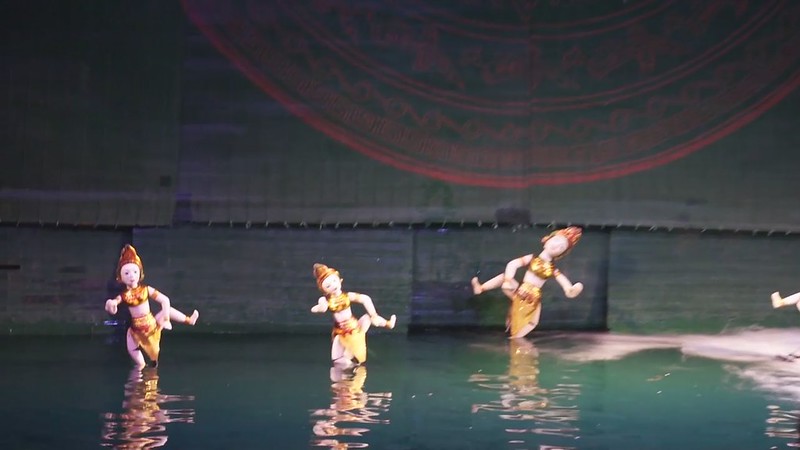For centuries, Vietnamese kids and grown-ups alike have been entertained by a unique kind of puppet show —one that is performed on water. The puppeteers stand in chest-deep pool of water, behind a curtain backdrop, and control wooden puppets via poles and strings hidden under the water, while the puppets dance over the water’s surface. A traditional Vietnamese orchestra provides background music while singers sing the story being acted out by the puppets. The water not only hides the puppet strings and puppeteer movements, it also provides opportunities for effects such as waves and splashes and shimmering lights.
Water puppetry is thought to have developed in the villages of the Red River Delta area of northern Vietnam in the 11th century. The original water puppet shows were held inside rice paddy fields after the harvest to celebrate the end of the harvest season. Later, communal ponds became stages for these impromptu performances, enhancing the widespread development of the art form.

Photo credit: Charles Chan/Flickr
The themes of play ranges from day-to-day lives to Vietnamese folk tales and legends. Stories of the harvest, of fishing and of festivals are often highlighted. Modern performances usually consist of several short sketches rather than one long story, taking the audience on a journey of ancient village life, agricultural harvests and dances of mythical creatures.
The puppets are made of wood and then lacquered to make it watertight and endurable. Each puppet stands about two feet tall and can weigh between 9 and 14 kg. Maneuvering them across the stage while synchronizing the movement of their limbs require strength, dexterity and sometimes two or three people. The puppet is usually fixed to a floating base at one end of a long bamboo. The base includes a rudder and acts as a fulcrum for the strings that control the upper body. The details of their tricks have been kept secret for centuries. Even today, village guilds of puppeteers refer to the more complex maneuvers only by code names.
Generation of puppeteers have suffered from water-borne diseases, rheumatism and leeches while practicing the craft. Early puppeteers downed strong doses of nuoc mam (a fish sauce) and ginger tea to help them endure bitingly cold winter performances. Modern puppeteers now wear protective clothing.
The Thang Long Water Puppet Theater in Hanoi is famous for these shows. Founded in 1969, the theater has since performed throughout the world.


Photo credit: groucho/Flickr

Photo credit: groucho/Flickr

Photo credit: Stephen McGrath/Flickr

Photo credit: Greg Willis/Flickr

Photo credit: Greg Willis/Flickr

Photo credit: Jason Wong/Flickr

Photo credit: Yuxuan Wang/Flickr

Photo credit: Richard Vignola/Flickr
Sources: www.vietnam-guide.com / Vietnam Online / www.sagecraft.com / Learn NC
Subscribe to our Newsletter and get articles like this delieverd straight to your inbox
Water puppetry is thought to have developed in the villages of the Red River Delta area of northern Vietnam in the 11th century. The original water puppet shows were held inside rice paddy fields after the harvest to celebrate the end of the harvest season. Later, communal ponds became stages for these impromptu performances, enhancing the widespread development of the art form.

Photo credit: Charles Chan/Flickr
The themes of play ranges from day-to-day lives to Vietnamese folk tales and legends. Stories of the harvest, of fishing and of festivals are often highlighted. Modern performances usually consist of several short sketches rather than one long story, taking the audience on a journey of ancient village life, agricultural harvests and dances of mythical creatures.
The puppets are made of wood and then lacquered to make it watertight and endurable. Each puppet stands about two feet tall and can weigh between 9 and 14 kg. Maneuvering them across the stage while synchronizing the movement of their limbs require strength, dexterity and sometimes two or three people. The puppet is usually fixed to a floating base at one end of a long bamboo. The base includes a rudder and acts as a fulcrum for the strings that control the upper body. The details of their tricks have been kept secret for centuries. Even today, village guilds of puppeteers refer to the more complex maneuvers only by code names.
Generation of puppeteers have suffered from water-borne diseases, rheumatism and leeches while practicing the craft. Early puppeteers downed strong doses of nuoc mam (a fish sauce) and ginger tea to help them endure bitingly cold winter performances. Modern puppeteers now wear protective clothing.
The Thang Long Water Puppet Theater in Hanoi is famous for these shows. Founded in 1969, the theater has since performed throughout the world.


Photo credit: groucho/Flickr

Photo credit: groucho/Flickr

Photo credit: Stephen McGrath/Flickr

Photo credit: Greg Willis/Flickr

Photo credit: Greg Willis/Flickr

Photo credit: Jason Wong/Flickr

Photo credit: Yuxuan Wang/Flickr

Photo credit: Richard Vignola/Flickr
Sources: www.vietnam-guide.com / Vietnam Online / www.sagecraft.com / Learn NC
Subscribe to our Newsletter and get articles like this delieverd straight to your inbox
Vietnamese Water Puppet Shows
4/
5
Oleh
Chandu Numerology










